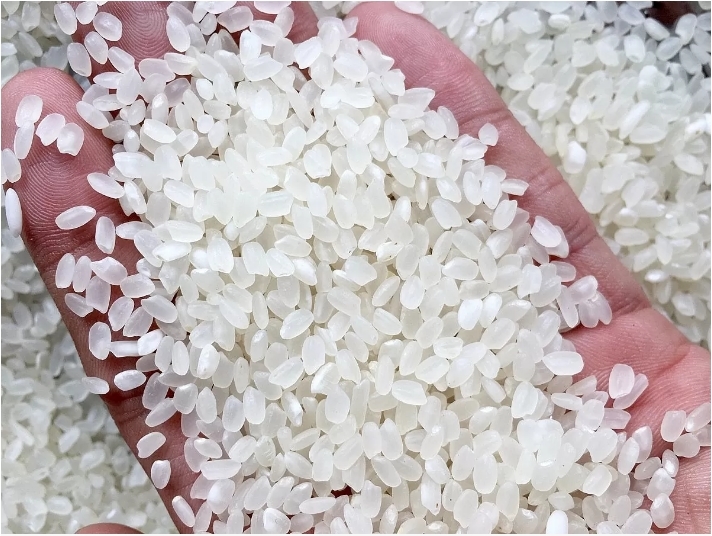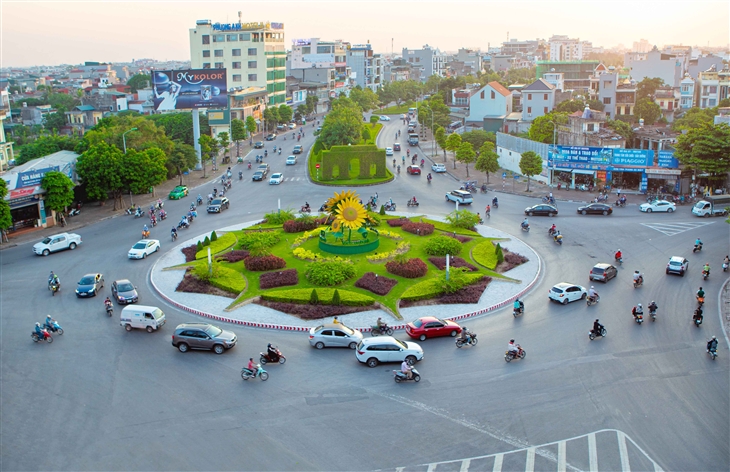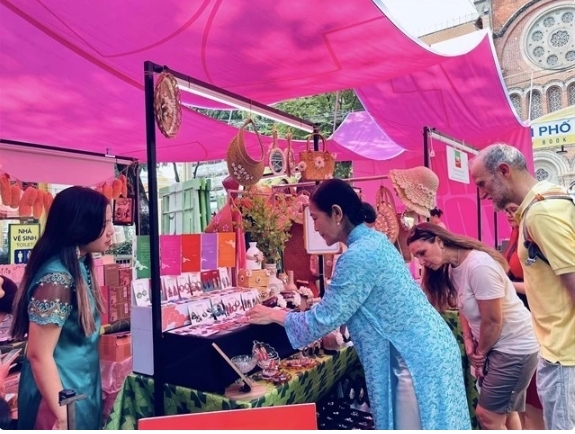Conquering Japanese market: Opportunity to increase value of Vietnamese rice
Thursday, May 15,2025
AsemconnectVietnam - Proactively choosing a demanding market segment, including the Japanese market, is a way to increase value of Vietnamese rice.
Proactively choosing a difficult market
"This May, we will export the first batch of rice with carbon emission labels to the Japanese market. Warehouse price of this batch is 785 USD/tonne, if adding the cost of delivery to the port, the selling price will be around more than 800 USD/tonne (FOB price). Opportunity in the Japanese market is huge", Mr. Pham Thai Binh - Chairman of Board of Directors of Trung An High-Tech Agriculture Joint Stock Company - shared with reporters of Cong Thuong Newspaper.
According to Mr. Pham Thai Binh, in order to export to this market, the Company has cooperated with Japanese enterprises, they bring seeds, engineers to guide, and enterprises must grow according to their process. Currently, the demand in the Japanese market is very large, however, enterprises can only meet a part of it.
"Orientation of PAN Group in general and Vinaseed (a subsidiary of PAN Farm under PAN Group) in particular, we put quality first and focus on the demanding market", Ms. Nguyen Thi Tra My - Vice President and General Director of PAN Group talked to reporters of Cong Thuong Newspaper.
According to Ms. Tra My, demand for rice consumption in the Japanese market is good, board of directors of Vinaseed has discussed and together found ways to export rice to Japan. We are confident about the quality, traceability from seeds to the table.
Accordingly, Vinarice, a member of Vinaseed Group, participated in project "Transforming the rice value chain to respond to climate change and sustainable development in the Mekong Delta region" (TRVC) of Australian Government and received good media effects. We cultivate to reduce emissions in the provinces of the Mekong Delta, the first crop resulted in a reduction of 3,888 tons of CO2 and received a reward of 28,600 AUD (Australian dollars). PAN and Vinaseed always look for demanding markets because when working with demanding markets, we can demonstrate the competitiveness of the business.
Strengthening connections, seizing market opportunities
Recently, Japanese Ministry of Agriculture, Forestry and Fisheries announced that in the week ending April 20, rice prices increased by 3 yen compared to the previous week, reaching an average of 4,220 yen equivalent to 29.38 USD for a 5kg bag of rice.
With Japanese consumers struggling with rising rice prices due to inflation, Prime Minister Shigeru Ishiba's government took an unprecedented step last month by releasing rice from the national reserves to the market to curb prices.
This measure will continue to be implemented monthly until July 2025. However, as domestic rice prices show no signs of cooling down, private companies are planning to increase rice imports outside of Japan's duty-free quota.
Vietnam is one of the world's leading rice exporters. Japan is short of rice, is this an opportunity for Vietnamese rice? Regarding this, according to Mr. Pham Thai Binh, the opportunity in the Japanese market is huge, however, the most important thing is whether Vietnamese rice can meet their requirements or not.
To export rice to a demanding market, including Japan, businesses must start from the production stage. Free trade agreements (FTAs) help reduce trade barriers or offer tariff incentives. But if rice does not meet market standards, it will not be able to enter.
To seize market opportunities, Mr. Pham Thai Binh said that farmers must cooperate with businesses and grow according to the requirements of businesses. On part of businesses, they must grow according to the standards of the importing country. To do this, the most important thing is to reorganize production according to the criteria of the "Project for sustainable development of 1 million hectares of high-quality and low-emission rice cultivation associated with green growth in the Mekong Delta by 2030" (Project) at that time, it will both reduce costs for farmers and increase the value of Vietnamese rice grains.
Sharing the same opinion on this issue, agricultural expert Hoang Trong Thuy said that although the Japanese market is short of rice, prices are at a very high level. However, whether Vietnamese rice can be exported to this market or not is another matter. Japan only imports Japanese rice varieties grown in Vietnam. They trace the origin down to the native varieties, grown according to organic standards, not just because they are delicious.
According to Mr. Hoang Trong Thuy, Japan has two types of rice imports: Rice imported by the government; rice imported by private companies such as trading companies and other companies. In the Japanese market, Vietnamese rice is competing with rice from the United States, Thailand, China or Australia. However, businesses and experts in the industry all believe that Vietnamese rice has won the trust of consumers around the world. Therefore, along with promoting market forecasting so that people, cooperatives and businesses can grasp and have orientation in production and export. Effective implementation of the 1 million hectares of high-quality, low-emission rice project will help increase production capacity, improve the value chain, and enhance the competitiveness of Vietnamese rice in the international market.
Source: Vitic/ congthuong.vn
"This May, we will export the first batch of rice with carbon emission labels to the Japanese market. Warehouse price of this batch is 785 USD/tonne, if adding the cost of delivery to the port, the selling price will be around more than 800 USD/tonne (FOB price). Opportunity in the Japanese market is huge", Mr. Pham Thai Binh - Chairman of Board of Directors of Trung An High-Tech Agriculture Joint Stock Company - shared with reporters of Cong Thuong Newspaper.
According to Mr. Pham Thai Binh, in order to export to this market, the Company has cooperated with Japanese enterprises, they bring seeds, engineers to guide, and enterprises must grow according to their process. Currently, the demand in the Japanese market is very large, however, enterprises can only meet a part of it.
"Orientation of PAN Group in general and Vinaseed (a subsidiary of PAN Farm under PAN Group) in particular, we put quality first and focus on the demanding market", Ms. Nguyen Thi Tra My - Vice President and General Director of PAN Group talked to reporters of Cong Thuong Newspaper.
According to Ms. Tra My, demand for rice consumption in the Japanese market is good, board of directors of Vinaseed has discussed and together found ways to export rice to Japan. We are confident about the quality, traceability from seeds to the table.
Accordingly, Vinarice, a member of Vinaseed Group, participated in project "Transforming the rice value chain to respond to climate change and sustainable development in the Mekong Delta region" (TRVC) of Australian Government and received good media effects. We cultivate to reduce emissions in the provinces of the Mekong Delta, the first crop resulted in a reduction of 3,888 tons of CO2 and received a reward of 28,600 AUD (Australian dollars). PAN and Vinaseed always look for demanding markets because when working with demanding markets, we can demonstrate the competitiveness of the business.
Strengthening connections, seizing market opportunities
Recently, Japanese Ministry of Agriculture, Forestry and Fisheries announced that in the week ending April 20, rice prices increased by 3 yen compared to the previous week, reaching an average of 4,220 yen equivalent to 29.38 USD for a 5kg bag of rice.
With Japanese consumers struggling with rising rice prices due to inflation, Prime Minister Shigeru Ishiba's government took an unprecedented step last month by releasing rice from the national reserves to the market to curb prices.
This measure will continue to be implemented monthly until July 2025. However, as domestic rice prices show no signs of cooling down, private companies are planning to increase rice imports outside of Japan's duty-free quota.
Vietnam is one of the world's leading rice exporters. Japan is short of rice, is this an opportunity for Vietnamese rice? Regarding this, according to Mr. Pham Thai Binh, the opportunity in the Japanese market is huge, however, the most important thing is whether Vietnamese rice can meet their requirements or not.
To export rice to a demanding market, including Japan, businesses must start from the production stage. Free trade agreements (FTAs) help reduce trade barriers or offer tariff incentives. But if rice does not meet market standards, it will not be able to enter.
To seize market opportunities, Mr. Pham Thai Binh said that farmers must cooperate with businesses and grow according to the requirements of businesses. On part of businesses, they must grow according to the standards of the importing country. To do this, the most important thing is to reorganize production according to the criteria of the "Project for sustainable development of 1 million hectares of high-quality and low-emission rice cultivation associated with green growth in the Mekong Delta by 2030" (Project) at that time, it will both reduce costs for farmers and increase the value of Vietnamese rice grains.
Sharing the same opinion on this issue, agricultural expert Hoang Trong Thuy said that although the Japanese market is short of rice, prices are at a very high level. However, whether Vietnamese rice can be exported to this market or not is another matter. Japan only imports Japanese rice varieties grown in Vietnam. They trace the origin down to the native varieties, grown according to organic standards, not just because they are delicious.
According to Mr. Hoang Trong Thuy, Japan has two types of rice imports: Rice imported by the government; rice imported by private companies such as trading companies and other companies. In the Japanese market, Vietnamese rice is competing with rice from the United States, Thailand, China or Australia. However, businesses and experts in the industry all believe that Vietnamese rice has won the trust of consumers around the world. Therefore, along with promoting market forecasting so that people, cooperatives and businesses can grasp and have orientation in production and export. Effective implementation of the 1 million hectares of high-quality, low-emission rice project will help increase production capacity, improve the value chain, and enhance the competitiveness of Vietnamese rice in the international market.
Source: Vitic/ congthuong.vn
Vietnam’s coal imports totaled over 2.5 billion USD in 4 months
Vietnamese durian has more competitors in the billion-people market
Decoding reasons for a peak in coconut export prices
Export increase, agricultural sector has trade surplus of over 5.1 billion USD
Vietnam’s exports to Netherlands increased in 4 months
Vietnam’s coffee exports increased in value in 4 months
Vietnam - Kazakhstan Cooperation: Opening way to high value, foundational industries
Vietnam's farm, forestry, and seafood trade in 4 months of 2025
Vietnam’s industrial production index increased in April
Vietnam's exports to UK increased in 4 months of 2025
Vietnam’s imports of goods from US increased in April
DAILY: Export rice prices increased slightly on May 9, 2025
DAILY: Domestic pepper prices remained unchanged on May 9, 2025
DAILY: Domestic coffee prices rose by 500 VND on May 9, 2025

Plan of Hai Duong province for a period of 2021 - 2030, ...
Organize space reasonably and harmoniously, focusing on connecting Hai Duong in common development space, actively contributing to the ...Plan of Hau Giang province in a period of 2021 - 2030, ...
Sustainable forestry development program in a period of ...

Art programme honouring Ao dai opens at HCM City Book ...
An art programme to honour and promote traditional cultural values and the beauty and grace of Ao dai has opened in Ho Chi Minh City. It ...From Hanoi to Brussels – a cross-cultural musical journey
Talented youngsters to enjoy int'l football ...
Tien Linh, Thuy Trang win Vietnam Golden Ball 2024
HCM City’s ao dai festival to feature mass folk dance with ...



